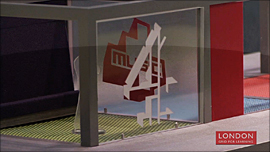KS3 Curriculum Links
Geography: Environmental interaction and sustainable development 1.6b
Exploring sustainable development and its impact on environmental interaction and climate change.
Science: The environment, earth and universe 3.4c
Human activity and natural processes can lead to changes in the environment.
KS4 Curriculum Links
Science: Energy, electricity and radiations 7a
Energy transfers can be measured and their efficiency calculated, which is important in considering the economic costs and environmental effects of energy use.
Key words
Natural lighting: lighting from the sun.
Artificial lighting: lighting from man-made lighting sources which rely on electricity.
Activity
Preparation: Choose 2 spaces in the building with different lighting levels, ideally one that has more artificial lighting and one that has more natural lighting.
Create a worksheet: draw a simple chart on a large piece of paper with a line numbered 1-10 and labeled ‘too dark’ at 1, ‘just right’ at 5 and ‘too bright’ at 10.
Materials: 1 large sheet of paper, post-its, pens, plan view drawings of the classroom.
Steps:
- Students each have post-it and pen and write on the post-it how light or dark they find the space – giving it a 1-10 score.
- All students then stick their post-it on the wall chart at the relevant number.
- Read the results and ask for an initial response as to why the group thinks this might be.
- Take the group into another space in the building and repeat the activity, sticking the students’ scoring post-its on the wall chart underneath those for the first space.
- Ask students to compare the results.
- Let’s investigate why.
- Split the group into 3 teams and give students in team 1 and 2 a plan view of the space. Assign the following investigations:
- Team 1: Count the number of lights in the classroom and label on the plan view.
- Team 2: Count the number of windows in the classroom and plot on the plan view.
- Team 3: Investigate how the lighting in the room is controlled: How many blinds, shutters or electric switches can they spot?
- Repeat this investigation in the second space.
- Ask all the teams to compare their findings and present these to the group.
- Lead a group discussion: From all of these findings, as a group agree why they scored the spaces differently on the 1-10 scale and therefore how the design of the space and its lighting can affect your experience of it.
- Ask students to suggest ways to control the light in the classroom to use less energy and keep a constant level of light.




